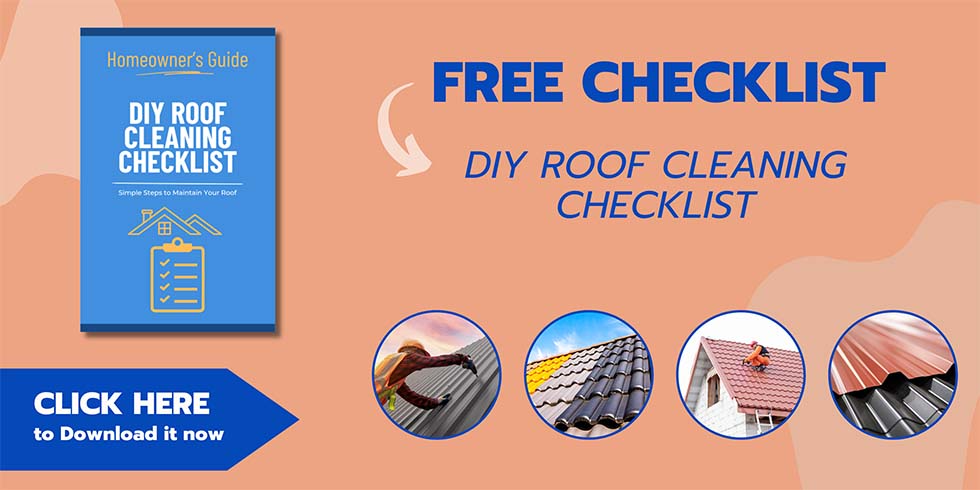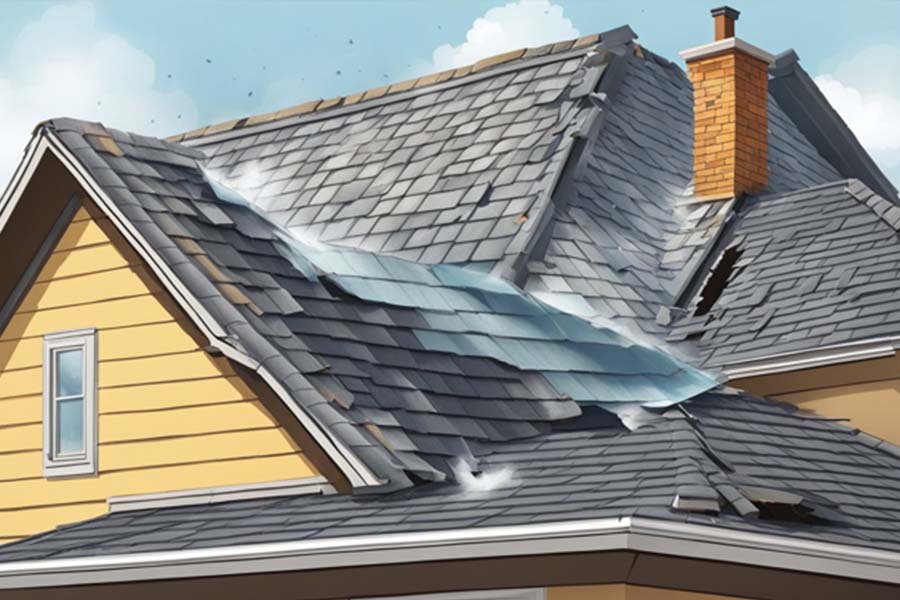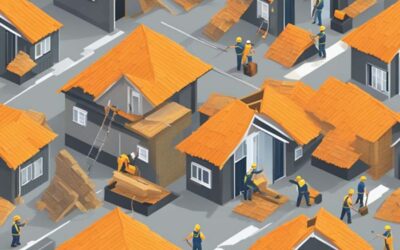Pressure washing is a popular method for cleaning the exterior of homes, including roofs. It’s a quick and easy way to remove dirt, grime, and moss buildup. However, pressure washing your roof can be dangerous and cause significant damage if not done correctly.
One of the main dangers of pressure washing your roof is the potential for water damage. High-pressure water can penetrate through shingles and underlayment, causing leaks and water damage to the interior of your home. Additionally, pressure washing can strip away protective coatings and granules from shingles, reducing their lifespan and effectiveness.
Another danger of pressure washing your roof is the risk of personal injury. Climbing onto a roof can be dangerous in itself, but add in the high-pressure equipment and slippery conditions, and it becomes a recipe for disaster. Inexperienced homeowners or contractors may not take proper safety precautions, leading to falls and other accidents.
Overall, while pressure washing can be an effective method for cleaning your home’s exterior, it’s important to understand the potential dangers and take appropriate precautions. Hiring a professional with experience in roof cleaning may be a safer and more effective option for maintaining the appearance and integrity of your roof.
Potential Roof Damage
High-Pressure Risks
Using a pressure washer on a roof can pose several risks. One of the most significant risks is the high-pressure water jet that can cause damage to the shingles and tiles on the roof. High-pressure water can strip away the granules on the shingles, which can lead to premature aging and deterioration of the roof. Additionally, it can cause the shingles to loosen or break, leading to leaks and other water damage.
Water Damage and Leaks
Another risk associated with pressure washing a roof is the potential for water damage and leaks. When water is forced under the shingles or tiles, it can cause damage to the underlayment and decking. This can lead to leaks and water damage inside the home. Additionally, water can seep into the attic or crawl space, causing mold growth and other issues.
To prevent these risks, it is important to hire a professional roofing contractor who has experience in cleaning roofs without causing damage. They can use low-pressure washing techniques and specialized cleaning solutions to safely and effectively clean the roof without causing damage. It is also important to regularly inspect the roof for any signs of damage or wear and tear, and to address any issues promptly to prevent further damage.
Warranty and Insurance Implications
Voiding Roof Warranties
Using a pressure washer to clean your roof can potentially void your roof warranty. Most roofing manufacturers have specific guidelines for cleaning and maintaining their products. If these guidelines are not followed, the warranty may be voided.
Pressure washing can cause damage to shingles, tiles, and other roofing materials. This damage can lead to leaks and other issues that may not be covered under warranty. In addition, using high-pressure water can remove protective coatings or granules on shingles, which can shorten the lifespan of the roof.
It is important to check with your roofing manufacturer before using a pressure washer on your roof. If the manufacturer does not recommend pressure washing, it is best to avoid it altogether to avoid voiding your warranty.
Insurance Claim Rejections
If damage occurs to your roof as a result of pressure washing, your insurance company may reject your claim. Insurance policies typically require that homeowners take reasonable care to maintain their property. If it is determined that pressure washing was not a reasonable method of maintenance, the claim may be denied.
In addition, some insurance policies specifically exclude damage caused by pressure washing. It is important to review your policy carefully and consult with your insurance agent before using a pressure washer on your roof.
Overall, it is important to weigh the potential risks and benefits of pressure washing your roof. If you decide to use a pressure washer, make sure to follow all manufacturer guidelines and take appropriate safety precautions. If you are unsure about the best method for cleaning your roof, consult with a professional roofing contractor.
Biological Growth Issues
Mold and Algae Proliferation
One of the most common issues that homeowners face when it comes to the growth of biological organisms on their roofs is the proliferation of mold and algae. These organisms thrive in damp and humid conditions and can quickly spread across the surface of a roof, causing unsightly stains and discoloration.
Pressure washing is often seen as a quick and easy solution to this problem, but it can actually make the situation worse. High-pressure water can force water and spores deeper into the roof’s surface, making it even harder to remove the growth and increasing the risk of damage to the underlying structure.
Instead of pressure washing, homeowners should consider using a specialized cleaner that is designed to remove biological growth. These cleaners are typically applied using a low-pressure sprayer and allowed to sit on the roof for a period of time before being rinsed away. This approach is much gentler on the roof and can be just as effective at removing the growth.
It’s important to note that while mold and algae growth may be unsightly, it’s not necessarily dangerous to your health. However, it can cause damage to your roof over time if left untreated, so it’s important to address the issue as soon as possible.
Overall, homeowners should avoid using pressure washing to remove biological growth from their roofs. Instead, they should opt for a gentler approach using specialized cleaners. By doing so, they can protect their roof and ensure that it lasts for years to come.
Safety Concerns
Personal Injury
Pressure washing a roof can be a dangerous task. The high pressure of the water can cause serious injuries if not handled properly. It is important to wear appropriate safety gear, such as gloves, goggles, and non-slip shoes. Additionally, it is recommended to have a partner assist with the task to ensure safety and prevent accidents.
Property Hazards
Pressure washing can also cause damage to the property if not done correctly. The high pressure of the water can strip off paint, damage shingles, and cause leaks. It is important to be aware of the type of roof material and adjust the pressure accordingly. It is also recommended to test a small area before starting the full pressure washing process.
Overall, pressure washing a roof can be a daunting task that requires caution and attention to detail. By following safety guidelines and taking necessary precautions, one can successfully pressure wash their roof without causing harm to themselves or their property.
Alternative Cleaning Methods
Soft Washing
Soft washing is a popular alternative to pressure washing for cleaning roofs. It involves using a low-pressure spray of water and cleaning solution to remove dirt, grime, and other debris from the roof surface. Soft washing is a safer option than pressure washing as it does not damage the roof shingles or tiles.
The soft washing process involves applying a cleaning solution to the roof surface, allowing it to sit for a few minutes, and then rinsing it off with a low-pressure spray of water. The cleaning solution is specially formulated to remove dirt, mold, and other stains from the roof without damaging it.
Eco-Friendly Solutions
For those who are concerned about the environment, there are eco-friendly cleaning solutions available that can be used to clean roofs. These solutions are made from natural ingredients and are safe for the environment.
One such solution is a mixture of vinegar and water. This solution is effective at removing dirt and grime from the roof surface without harming the environment. Another eco-friendly solution is a mixture of baking soda and water. This solution is also effective at removing stains and dirt from the roof surface.
In addition to using eco-friendly cleaning solutions, it is also important to use eco-friendly cleaning tools. For example, using a broom or brush to remove debris from the roof is a more eco-friendly option than using a leaf blower.
Overall, there are safer and more eco-friendly alternatives to pressure washing for cleaning roofs. Soft washing and eco-friendly cleaning solutions are effective at removing dirt and grime from the roof surface without causing damage to the roof or the environment.





0 Comments